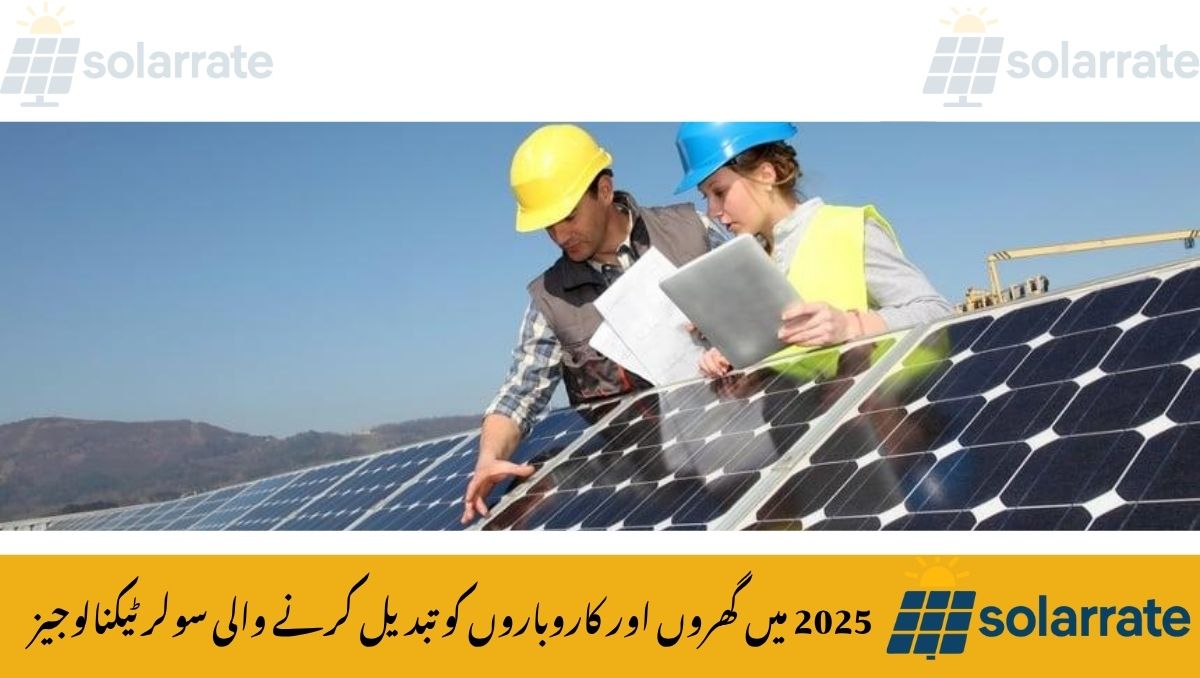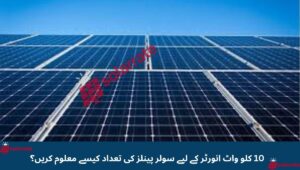As solar energy enters a new era of development, modern technology is making it more efficient, connected, safe, and beautiful. Solar Technologies for Homes and Businesses 2025 have now become a force that can completely transform home and business energy systems.
Visit Now:https://cmsolarscheme.punjab.gov.pk/

Ultra-high-efficiency and state-of-the-art solar panels
☀️ Perovskite and Tandem Cells
Solar Technologies for Homes and Businesses 2025 include perovskite silicon tandem cells that are now achieving commercial efficiencies of around 28 to 29 percent, a major advance over conventional silicon panels.
📈 For example, Hanwha Q Cells recently achieved a record efficiency of 28.6%.
🧪 Ultra-Thin Flexible Panels
🇯🇵 Japan is investing $1.3 billion to develop an ultra-thin perovskite film, part of Solar Technologies for Homes and Businesses 2025, that can be easily applied to curved surfaces such as stadiums or roofs.
🌀 The technology will enable installations that are almost invisible and highly adaptable.
Also Read:How Solar Energy Is Cutting Electricity Bills 2025 and Saving You $3,000+
Smart Integration: AI + IoT
🤖 Automated Management Systems
Now, with the help of AI and smart sensors, solar systems not only improve energy production, but also:
📊 Predict output based on weather forecasts
🔧 Detect repair or maintenance needs early
⚡ React in real time — reducing downtime and increasing performance
🌦️ Predictive Weather Control
Modern tracker systems, such as Nextracker’s AI-powered arrays, automatically:
🔄 Adjust panel angles based on weather predictions
🌨️ For example, they can shift panels before a hailstorm to avoid damage
Modern energy storage systems and multipurpose grids
🔋 Battery and EV Integration
Lithium-ion and solid-state batteries are now becoming increasingly common, enabling solar systems to store additional energy, while electric vehicles are now acting as mobile storage units with bi-directional charging capabilities. Solar Technologies for Homes and Businesses 2025 support this advancement.
🚗 They charge from the sun during the day and provide power to the home or grid at night or during peak power demand.
🌾 The Popularity of Agrivoltaics
The use of solar energy in conjunction with agriculture, such as sheep and goats grazing under panels, is now spread over more than 9 gigawatts worldwide. Solar Technologies for Homes and Businesses 2025 are helping expand such innovative solutions globally.
🌿 This method allows for more efficient use of land and also helps with other farm operations.
🌊 Floating Solar Farms
Solar panel systems on reservoirs and ponds are now not only generating electricity, but are also increasing efficiency by utilizing the water surface. 💧 These systems, part of the growing Solar Technologies for Homes and Businesses 2025, take advantage of the natural cooling of the water, which makes the panels more efficient and reduces the land’s needs.
Also Read:Solar Panel Market Trends New Prices Announced Across Pakistan (June 2025)
Integrated and transparent solutions in buildings
🪟 And Solar Windows
Under BIPV, building integrated photovoltaics are being implemented in buildings including solar shingles, facades, and windows, which provide energy to the building and replace traditional construction materials. These innovations are a key part of Solar Technologies for Homes and Businesses 2025, thereby reducing the cost of installation along with enhancing aesthetics and functionality.
🌞 Transparent Solar Glazing
IR and UV invisible solar coatings are being developed that generate electricity by absorbing energy such as light while maintaining the transparency of the window.
✨ Quantum Dot Solar Glazing
Modern research is using quantum dot luminescent solar concentrators that form semi-transparent glazing.
🏢 This technology enables communication along with daylight in smart buildings.
Change in grade and business level
🏗️ Ease of Utility-Scale Deployment
Contracted solar capacity is doubling that of wind power through easy modular permitting, leading to large-scale renewable energy PPAs across a range of industries.
🏫 Community and Public Sector Rollouts
Governments are rolling out solar projects on schools, hospitals, and other public buildings.
🇬🇧 For example, one project in the UK will install solar panels on around 400 sites, with each site saving around £25,000 to £45,000 per year.
💼 Solar Buybacks and Asset Monetisation
Businesses are freeing up capital by selling their solar assets to investors or utility companies, making installations more financially stable and strategic.
What does this mean to you?
| Segment | Impact and Takeaways |
|---|---|
| 🏠 Homeowners | – Reduce grid dependency and lower electricity bills with efficient solar panels and smart batteries. – Elegant BIPV solutions preserve home design. – EVs can serve as backup power. |
| 🏢 Small Businesses | – IoT-enabled solar systems improve operations and enhance energy flexibility. – Solar buybacks and community programs support low-cost energy adoption. |
| 🏭 Commercial & Utility | – Scalable trackers, floating farms, and agrivoltaics speed up deployment. – Off-grid storage increases ROI and energy reliability. |
Future scenarioSolar Technologies for Homes and Businesses 2025
🔮 Looking Ahead: The Future of Solar in 2025
In 2025, solar energy will no longer be limited to generating electricity, but will become a smart, integrated, and multifunctional system. Solar Technologies for Homes and Businesses 2025 will drive this transformation. You can expect:
⚡ Energy efficiency will increase further with the help of tandem and perovskite panels.
🧩 Flexible, transparent, and modular solar installations will be adopted more widely.
🔋 There will be better integration between solar energy, storage batteries, electric vehicles, and grid intelligence.
🏫 Large-scale solar energy programs will be implemented in the community and public sector.
Also Read:Solar Air Conditioner Prices 2025 and Key Specifications Explained
Conclusion
The transformation of solar energy is no longer limited to just generating energy, but consists of modern, multi-faceted and intelligent systems that are reshaping the way we use energy in everyday life. Solar Technologies for Homes and Businesses 2025 are driving this evolution. Whether it’s on your roof, on commercial buildings, or in large utility farms, solar energy is becoming a key pillar of our energy future.
FAQ’s
What are the latest Solar Technologies for Homes 2025
The latest solar technologies include high-efficiency panels, smart energy storage, and AI-powered management systems.
How do Solar Technologies for Homes 2025 improve energy savings?
They increase efficiency and optimize energy use, reducing electricity bills for both homes and businesses.
Are Solar Technologies for for Homes and businesses 2025 affordable?
Yes, with government subsidies and falling equipment costs, these technologies are becoming more affordable.
Can Solar Technologies for Homes 2025 work in all climates?
Most technologies are designed to perform efficiently in diverse weather conditions, including cloudy and sunny areas.
What is the impact of Solar Technologies for Homes and businesses 2025 on the environment?
They reduce carbon footprints by using clean, renewable energy and decreasing reliance on fossil fuels.



![Read more about the article Canadian N-Type Bifacial Panel Price Today in Pakistan – [2025]](https://solarrate.online/wp-content/uploads/2025/06/Canadian-N-Type-Bifacial-Panel-Price-Today-2-300x170.jpg)
